COLUMNS
360º Architecture
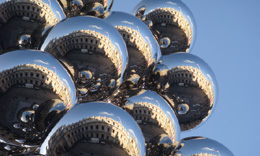
26 November, 2009
Anish Kapoor: Non-objective Objects
At the Royal Academy of Arts, in London, Anish Kapoor is currently exhibiting a number of works in which, at different times in his career, he searched for ways to think about what he calls ‘the non-objective object,’ or ‘how an object can be and not be’. 
In the Italian fifteenth and sixteenth centuries, the social position of the artist was significantly elevated. Architects, painters and sculptors struggled to attain recognition of their professions as liberal arts, fundamentally different from the manual crafts, and of themselves as members of humanist society. They claimed that their reliance on the methods of reason, their humanist learning, their scientific studies of the material world through observation and measurement, and their application of geometry and mathematical perspective in the production of their works distinguished them from their mediaeval predecessors, mere craftsmen who 'performed a practical function under the direction of the Church, and through the organization of the Guilds'.(1) In his preface to The Ten Books of Architecture, Leon Battista Alberti explicitly contrasted the architect with the craftsman: 'it is not a Carpenter or Joiner that I thus rank with the greatest Masters in other Sciences; the manual Operator being no more than an Instrument to the Architect.'(2) In their disputes about the relative dignity of the various arts, the Renaissance artists argued that the finer art is the one that achieves a more faithful representation of nature. For Leonardo, for example, painting is superior to poetry because the painter 'makes images of the works of nature with more truth than the poet', and finer than sculpture because it can depict a much greater variety of natural phenomena such as storms and clouds. The uncontested dependence of architecture on a knowledge of the liberal art of mathematics granted architects public respect at an earlier stage, and increased the rivalry that painters and sculptors felt with them. The painters demanded equal status with the poets: for 'If poetry deals with moral philosophy,' contended Leonardo, 'painting deals with natural philosophy', and the painters' instruments, just like those of the poets, are guided by the imagination, which distinguishes their art from the manual and the mechanical. It was also on the basis of the superiority of intellectual over manual work that painters like Leonardo claimed superiority over sculptors: 'the painter sits in great comfort before his work, well dressed, and wields his light brush loaded with lovely colours. He can be dressed as well as he pleases, and his house can be clean and filled with beautiful paintings. He often works to the accompaniment of music, or listening to the reading of many fine works. And all this can be heard without being drowned with the sounds of hammering or other uproar', a reference to the labour of the sculptor who, 'covered with dust and sweat...looks like a baker'.(3) The visual artists' emancipation from the world of the old guilds granted them a new-found freedom to create as individuals and even to carry out works other than those directly commissioned, even though initially only to a limited extent.
The degree to which artists create their work with the hand or with the mind has been variously debated in the history of art. The anxiety to dissociate themselves from the craftsmen appears to persist among artists to the present day. In the 1930s, French abstract artists coined the term abstraction-création, in order to distinguish between forms that derive from visual experience and pure forms of the artist's creation, thus introducing a new dichotomy between what the eye sees and what the mind conceives. Abstract artists from the 1950s onwards have insisted that what they present to the viewer is not a found, known or pre-conceived object, but a previously unknown one, which they add to the world of forms, a work of pure invention rather than observation, creation rather than representation. The struggle of artists to eliminate any resemblance to recognizable objects in their 'nonobjective' art began in Europe before World War II, but its appeals to the unconscious, to chance and to a total detachment between the artwork and anything outside itself intensified in the US after the war. Jackson Pollock told an interviewer: 'I try to stay away from any recognisable image; if it creeps in, I try to do away with it.'(4) Nevertheless, each time an artist invents a new form, it grants name and shape to a previously unknown thing. 'This is one of abstraction's singular qualities,' says Kirk Varnedoe, 'the form of enrichment and alteration of experience denied to the fixed mimesis of known things'. But now we do understand, he soon adds, 'that even the seemingly purest abstraction that looks like a fat zero is in fact often an egg waiting to hatch'. For the forms that artists invent become 'a new alphabet that many others - artists, designers, filmmakers and so on - can use to represent the world in very different ways,'(5) that is, to generate their own unique forms for others to ensure that this kind of world-enriching, open-ended process of radical innovation may never cease.
At the Royal Academy of Arts, in London, Anish Kapoor is currently exhibiting a number of works in which, at different times in his career, he searched for ways to think about what he calls 'the non-objective object,' or 'how an object can be and not be'.(6) Yellow (1999, installed at the Haus der Kunst, Munich, 2007-08) is one of his works that relies on the power of the material existence and factual immediacy of precisely-applied pure pigment to eliminate the sense of human gesture, and suggest 'something which was as if unmade, as if self-manifest', unmediated by its author. And yet, the neutrality of pure pigment is undermined by the sheer scale of the blinding monochrome with the deep recession at its centre, which magnetizes the viewers and immerses them into the sensational experience of vibrant colour, in an almost literal translation of the powerful draw exerted by Barnett Newman's fields of colour.
A group of sculptures that Kapoor exhibits together at the Royal Academy for the first time (Greyman Cries, Shaman Dies, Billowing Smoke, Beauty Evoked, 2008-09) began as a series with working titles such as Between Shit and Architecture or Electronic Ruins. These are 'printed' works, prodigiously produced through a computerized, automated process, whereby a three-dimensional printer lays coil upon coil of raw concrete, like anonymous excrement or architectural debris, the two bound together in the working title that leads Homi K. Bhabha to interpret the work as a metaphor of urban life.(7) What is unusual about these works in the context of Kapoor's oeuvre is their soft, muffling tissue that evokes handwork and pre-industrial craft, turning on its head the romanticism and organicism of works that used similarly-looking materials to critique hard-edged, impersonal abstraction, and updating the idea of the self-made, technologically-produced object. Kapoor's humble industrial material is poured out of the machine in its raw state, much like Pollock's paint was poured out of the can, producing what seems like a mere record of the event. 'To make art without the hand is a goal that sets art beyond expression,' affirms Kapoor, faithful to a tradition that demands from the artist a work purely of the mind, even though the reasons change with the times. And he positions his electronically-generated sculptures back on their pedestals: plywood palettes, humble waste material themselves too.
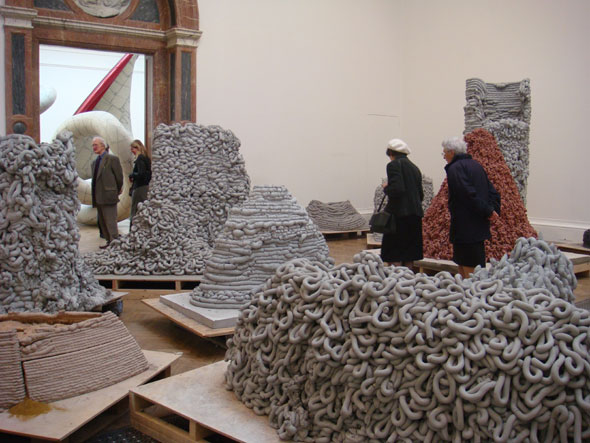
Anish Kapoor, Greyman Cries, Shaman Dies, Billowing Smoke, Beauty Evoked, 2008-09, detail, Royal Academy of Arts, London, 26 September - 11 December 2009, photograph by Styliane Philippou
Increasing reliance on scientific and later industrial processes for the production of works of art seemingly not made by human hand has both continued to support the notion of the artist as a free, imaginative inventor, as opposed to a servile craftsman, and reinforced the artists' claim upon ever new realms of pure, 'nonobjective' objects, that is, the idea that every artist produces forms unique to themselves. Varnedoe's example of how things get recycled, re-invented and re-imagined begins with Robert Morris's set of mirrored cubes of 1965 (Untitled, destroyed), apparently neutral, industrially-made objects, that forced the spectators to recognize the space around them as part of the work of art.(8) I venture to extend the lineage with a further example of how the possibilities offered by these mirrored cubes have been expanded. Anish Kapoor's impeccably polished, stainless steel, orthogonal block of 1997 (Untitled, private collection) had one of its larger sides concave, distorting the space around itself and inducing a physical sensation that is disturbing rather than neutral. Kapoor has explored the possibilities of these reflective, distorting and disturbing objects in an ever-expanding palette of means of distortion and materials - aluminium and lacquer, fibreglass and paint, chromed bronze etc. - and he has given some of them titles that confirm his intentions. Turning the World Inside Out (1995, installed at the Fondazione Prada, Milan, 1995-96, collection Fondazione Prada, Milan) did precisely what its title suggests in two ways: literally and with regard to earlier experiences of similar works. Vertigo (2008, installed at Gladstone Gallery, New York, 2008) returns equally distorted reflections of the viewers, the sounds they produce and their surroundings, dislocating their idols and flipping images upside down.
'Mirrored objects,' Kapoor explains, 'are like chameleons, seeming to camouflage themselves within their surroundings. Concave mirrored objects complicate this equation, by confusing our notions of space, turning the world upside down. Like lenses, their focal point hovers at some distance from them. As the viewer reaches this point, a physical sensation of vertigo is induced.'(9) In one of the rooms of the Royal Academy of Arts, Kapoor has installed a series of mirrored objects he calls Non-objects, thus continuing the tradition of describing abstract art through negative terms, underlining the works' remoteness from nature and previous experience, and drawing attention to the material power and the viewer's experience of the works, which ranges from the strange and the confusing to the disorienting and the painful. Between 2004 and 2009, Kapoor extended the potential of his mirrored objects by installing them in various locations at a monumental scale, addressing the city (Cloud Gate, 2004, Millennium Park, Chicago, 2004; Sky Mirror, 2006, Rockefeller Centre, New York City, 2006) or landscaped gardens (S-Curve, 2006, Kistefos Museum, Norway, 2008; Sky Mirror, 2009, Brighton Pavillion, UK, 2009), and engaging a larger public. These mirrored objects draw out some kind of otherness from the space around them and embark, in the words of Kapoor, on 'a new kind of spatial adventure. To make new art,' he declares, 'you have to make new space'.(10)
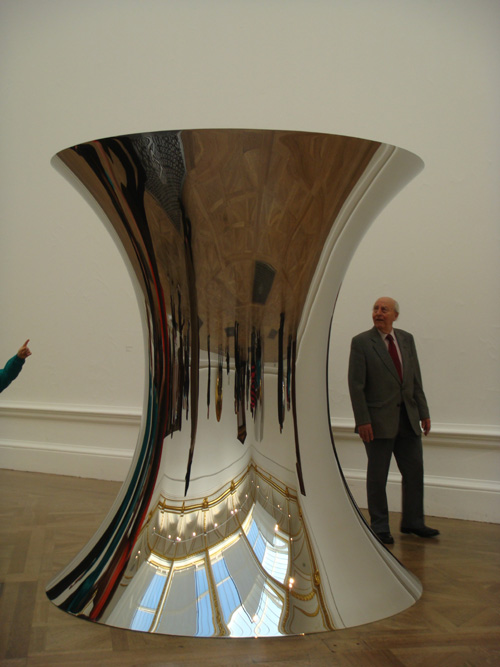
Anish Kapoor, Non-object (Pole), 2008, Royal Academy of Arts, London, 26 September - 11 December 2009, photograph by Styliane Philippou
Tall Tree and the Eye (2009), the luminous, fifteen-metre tall sculpture Kapoor installed in the Annenberg Courtyard of the Royal Academy is an assembly of large, mirror-polished, stainless-steel spheres, precariously balancing on top of one another, apparently floating in the air, playfully reflecting their vain surroundings. The effect is monumental, celebratory and magical. Undermining the reliable meaning of signs, Kapoor's iron balls hover seemingly weightless, seeking the kind of aesthetic sensation that results when the familiar relation between material and weight is rendered strange. One is reminded, once more, of the time when painting, sculpture and architecture gained acceptance as liberal arts, and their product began to be seen as a work of art, 'distinct from an object of practical utility, as something which is justified simply by its beauty and which is a luxury product'.(11) Sparkling, glamorous and spectacular, Kapoor's beautiful tree embraces the London world of glitz and consumer culture just outside the building of the Royal Academy, unashamedly aware of Jeff Koons's shiny, stainless steel Rabbit (1986, Eli & Edith Broad collection, Los Angeles). Responding to Leonardo's criticism of sculpture, it also depicts natural phenomena such as storms and clouds. And, as Varnedoe reminds us, no matter how much abstract artists like Kapoor may try to enforce the non-objectivity of their objects, no matter how hard they may work to dispel the ghosts of resemblance, confuse visual perception and suppress apparent figuration, visual perception always involves what Ernst Gombrich calls 'the viewer's share'.(12) Tall Tree and the Eye has inspired numerous associations, including that to a seasonal Christmas tree, proposed by a fellow-visitor.
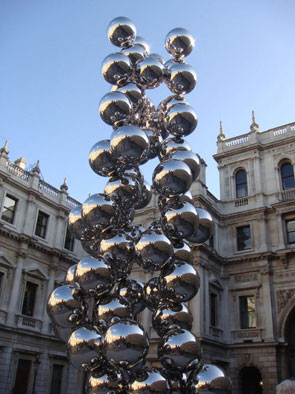
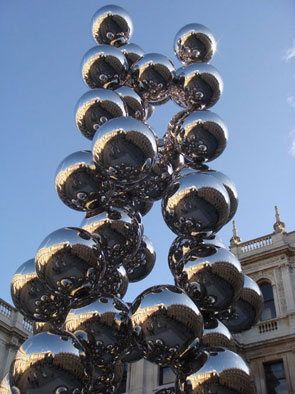
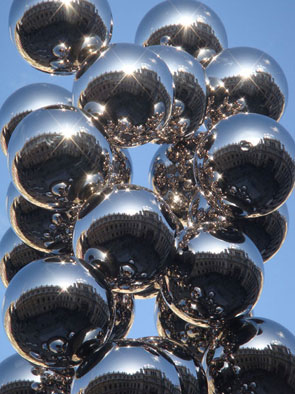
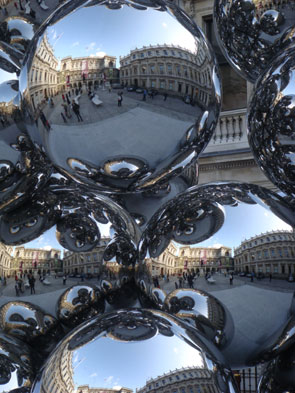
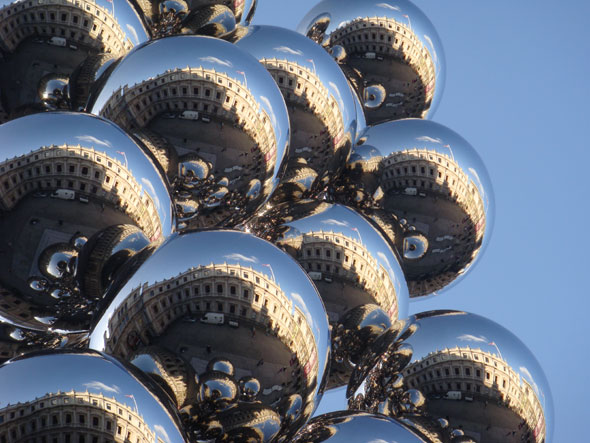
Anish Kapoor, Tall Tree and the Eye, 2009, Annenberg Courtyard, Royal Academy of Arts, London, 26 September - 11 December 2009, photograph by Styliane Philippou
For Herzog & de Meuron's first skyscraper, a luxury residential tower on the corner of 56 Leonard Street in Tribeca, New York City, Anish Kapoor explored various ways to bring together the architectural and the sculptural objects, stretching and squeezing, pushing and pulling, inflating and deflating his mirrored stainless-steel object as if it were a soft, elastic, air-filled, malleable balloon, infiltrating architectural space, undermining the autonomy, the authority and the integrity of both the architectural and the sculptural object, and re-interpreting the urban landmark. Although what is put forward as the final solution is not quite as radical as earlier versions displayed at the Royal Academy, his proposed mirrored object props up the building, incorporating two structural columns, while also appearing squashed by it, at once distorting the work of the architects and being distorted by it, as if the quarrels between artists about the relative nobility of their arts were still unfolding.
Notes
1. Blunt, Anthony, 1978, Artistic Theory in Italy 1450-1600 (Oxford and New York: Oxford University Press), pp. 1-2.
2. Alberti, Leon Battista, 1986, The Ten Books of Architecture (New York: Dover Publications, the 1755 Leoni edition).
3. Quoted in Blunt, pp. 27, 52-55.
4. Quoted in Varnedoe, Kirk, 2003, Pictures of Nothing, The A. W. Mellon Lectures in the Fine Arts, National Gallery of Art, Washington, DC (Princeton and Oxford: Princeton University Press), p. 32.
5. Varnedoe, pp. 34-36.
6. From 'Anish Kapoor in Conversation with Heidi Reitmaier, July 2007', extract cited in Anish Kapoor, 2009 (London: the Royal Academy of Arts, exhibition pamphlet).
7. Bhabha, Homi K., 2009, 'Elusive Objects: Anish Kapoor's Fissionary Art'. Anish Kapoor (London: Royal Academy of Arts, exhibition catalogue), pp. 29-30 and p. 35, n. 4.
8. Varnedoe, p. 36.
9. Anish Kapoor, 2009 (London: the Royal Academy of Arts, exhibition pamphlet).
10. Anish Kapoor.
11. Blunt, p. 55.
12. Varnedoe, pp. 31-33.
Related articles:
- 360 Degrees Architecture ( 10 October, 2009 )
- Τhe Roots of the Industry of the Image ( 27 October, 2009 )
- Love Thy Planet ( 28 December, 2009 )
- Europe’s Civilization under Threat ( 28 January, 2010 )
- Made of Stone and Water, for the Human Body ( 28 February, 2010 )
- Bokja: ‘A Woman’s Affair’ ( 28 March, 2010 )
- Brasília from the Beginning, Fifty Years Ago ( 07 April, 2010 )
- Brasília, ‘capital of the highways and skyways’ ( 30 April, 2010 )
- Oscar Niemeyer’s Permanent International Fair in Tripoli ( 29 May, 2010 )
- Learning from Miami ( 10 July, 2010 )
- The Greatest Show on the Beach ( 08 August, 2010 )
- Oscar Niemeyer: Curves of Irreverence ( 28 March, 2011 )
- The Lizards of Djenné ( 26 September, 2010 )
- Transformed by Couture ( 29 October, 2010 )
- Another Athens Is Possible ( 02 December, 2010 )
- From Juan O’Gorman for Diego Rivera and Frida Kahlo ( 28 February, 2011 )
- Roberto Burle Marx: The Marvellous Art of Landscape Design ( 27 May, 2011 )
- The Danger that Lurks on this Side of the Gates ( 10 September, 2011 )
- Eduardo Souto de Moura ( 21 November, 2011 )










